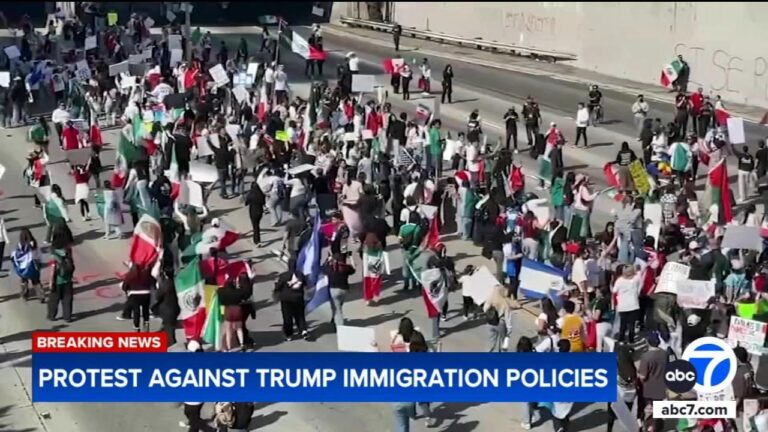Nationwide Surge in Anti-ICE Demonstrations Highlights Growing Immigration Reform Movement
Expansion of Anti-ICE Protests Across Major U.S. Cities
What began as localized protests against U.S. Immigration and Customs Enforcement (ICE) in Los Angeles has swiftly evolved into a widespread movement, reaching metropolitan centers such as New York City and Chicago. Activists are increasingly mobilizing to challenge ICE’s enforcement tactics and the conditions within detention facilities, demanding important policy changes and the dismantling of immigrant detention centers nationwide. This surge in activism reflects a broadening public discontent with current immigration enforcement strategies and signals a pivotal moment in the national conversation on immigration.
Recent highlights from these protests include:
- Mass gatherings of thousands near ICE offices in Manhattan and Chicago over consecutive weekends
- Formation of alliances between grassroots immigrant advocacy groups and national organizations
- Strategic use of digital platforms to raise awareness and organize peaceful civil disobedience actions
| City | Date of Protest | Primary Demand |
|---|---|---|
| New York | April 15, 2024 | Shut down local detention facilities |
| Chicago | April 22, 2024 | Stop family separations |
| Los Angeles | April 7, 2024 | Redirect city funds away from ICE operations |
Calls for Comprehensive Immigration Policy Overhaul from Community Advocates
Community leaders and activists in key urban areas are intensifying their push for sweeping reforms to immigration enforcement policies as protests against ICE gain traction beyond the West Coast. These voices emphasize the necessity of prioritizing human dignity, transparency, and accountability within immigration agencies. Public forums and town hall meetings have brought to light concerns not only about deportation practices but also about the broader social and familial impacts of current enforcement methods.
Advocates have outlined several critical reform proposals, including:
- Establishing rigorous oversight and accountability frameworks for ICE operations
- Expanding access to legal representation and support services for detainees and their families
- Investing in community-based alternatives to detention that respect human rights
- Eliminating policies that entangle local law enforcement with federal immigration enforcement
| City | Recent Rally Attendance | Featured Speaker |
|---|---|---|
| Los Angeles | 5,000+ | Maria Hernandez, Immigration Rights Advocate |
| New York | 3,200 | Jamal Turner, City Council Member |
| Chicago | 2,800 | Leila Gomez, Community Organizer |
Law Enforcement’s Adaptive Measures Amid Rising Protest Activity
In response to the escalating demonstrations targeting ICE, law enforcement agencies in cities like Los Angeles, New York, and Chicago have adjusted their operational tactics. Police departments have increased their presence near protest venues while fostering communication channels with organizers to maintain peace and prevent escalation. Authorities stress their commitment to safeguarding public order while respecting citizens’ rights to assemble peacefully, employing de-escalation strategies and deploying specialized units only when necessary.
Notable law enforcement strategies include:
- Enhanced intelligence gathering and monitoring to anticipate protest activities
- Partnerships with local advocacy groups to support lawful demonstrations
- Deployment of rapid response teams trained in crowd management and emergency medical aid
- Monitoring social media to identify and mitigate potential flashpoints
| City | Officers Deployed | Protests in Past Week | Reported Incidents |
|---|---|---|---|
| Los Angeles | 150 | 4 | 2 |
| New York | 120 | 3 | 1 |
| Chicago | 100 | 2 | 0 |
Effective Approaches to Supporting Peaceful Protest Movements
Given the complexity and scale of anti-ICE protests spreading through cities such as Los Angeles, New York, and Chicago, a thoughtful and strategic approach is essential. Organizers and community leaders are encouraged to maintain open communication, promote nonviolent principles, and implement conflict resolution protocols to ensure demonstrations remain constructive and focused on advocating humane immigration reforms.
Supporters can contribute meaningfully by adopting the following practices:
- Offering legal assistance and deploying legal observers during protests
- Providing essential supplies such as water, masks, and first aid kits to participants
- Collaborating with local organizations to coordinate logistics and resources
- Leveraging social media platforms for timely updates and accurate data dissemination
| City | Primary Focus Areas | Community Partners |
|---|---|---|
| Los Angeles | Border rights, family reunification | Local legal aid clinics, immigrant advocacy groups |
| New York | Access to detention centers, ICE budget cuts | Faith-based organizations, civil rights coalitions |
| Chicago | Deportation defense, sanctuary city policies | Community boards, human rights networks |
Conclusion: The Growing Impact of Anti-ICE Activism on Immigration Policy
The expansion of anti-ICE protests from Los Angeles to other major urban centers like New York and Chicago marks a significant escalation in public engagement with immigration enforcement issues. This movement not only amplifies demands for reform but also reflects deep societal divisions and evolving political dynamics surrounding immigration. As these demonstrations continue to unfold, they are poised to influence policy debates and legislative actions at local, state, and federal levels, shaping the future landscape of immigration enforcement in the United States.




